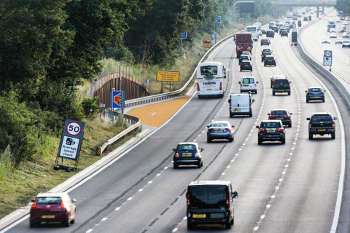The latest evaluation of an all lane running smart motorway scheme suggests that the increase in greenhouse gas emissions was nearly double what was anticipated.
Highways England has published a one-year post opening project evaluation (POPE) of the M3 junctions 2 to 4a ALR scheme, which opened in 2017. The document is the first POPE of a smart motorway scheme to be published since a raft of evaluations was released as part of last year’s smart motorway stocktake.

50mph limits on the scheme were lifted in August 2017
The document notes that the scheme appraisal ‘predicted that the scheme would have an adverse impact on carbon emissions dues to changes in traffic flows following the implementation of the scheme’.
However, greenhouse gas emissions for the scheme during the opening year (2017-2018) were even higher than the prediction, with observed emissions of 211,881 tonnes of CO2, compared with a forecast of 196,660.
The scheme's February 2014 Environmental Assessment Report calculated that the increase in carbon dioxide emissions in the opening year would be 23,242 tonnes - meaning the actual increase was around double the amount predicted.
Chris Todd, director of Transport Action Network said: ‘New roads create new traffic and this increases emissions at the very time we need to be drastically reducing them. With the M2 J2-4A Smart motorway, the reality is far worse than predicted. It has resulted in an increase of around 40,000 tonnes CO2 per year, instead of just over 20,000 tonnes.
‘If Highways England cannot accurately assess the impact that new roads are having on climate change, how can it say that the programme is Paris [Agreement] compliant? If we carry on like this, transport is going to continue to fail on climate change.’
The POPE study states that a full evaluation of the scheme requires forecast and observed traffic data for the whole study area but traffic data is not usually available for the whole area (ie beyond the scheme itself). Only data for the scheme's extent is available.
‘This means that the evaluation considers just the opening year emissions for the scheme extent itself.’
A Highways England spokesperson said: ‘This study found that in the first year the number of road users was lower than expected, but there was a higher number of heavy goods vehicles, which is a factor in calculating carbon emissions. This evaluation provides an early indication of the scheme’s outcomes and we will evaluate the longer-term effect before concluding the impacts of the scheme.
‘We take our environmental responsibilities seriously and are proud of our track record of delivering vital road upgrades in a way that respects the environment. While any road scheme will inevitably have some environmental impact we work hard to understand it and agree appropriate mitigation that protects and enhances the surrounding environment. We are also playing a full role in preparing the country's road network for a low carbon future.’
Register now for full access
Register just once to get unrestricted, real-time coverage of the issues and challenges facing UK transport and highways engineers.
Full website content includes the latest news, exclusive commentary from leading industry figures and detailed topical analysis of the highways, transportation, environment and place-shaping sectors.
Use the link below to register your details for full, free access.
Already a registered? Login